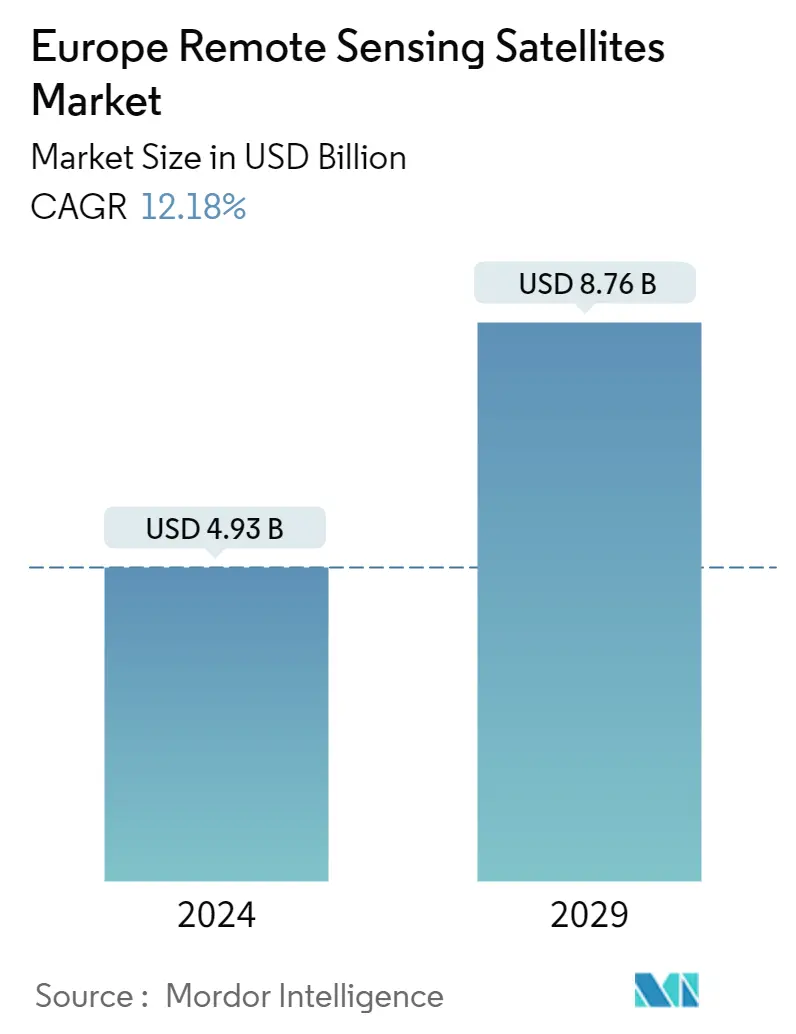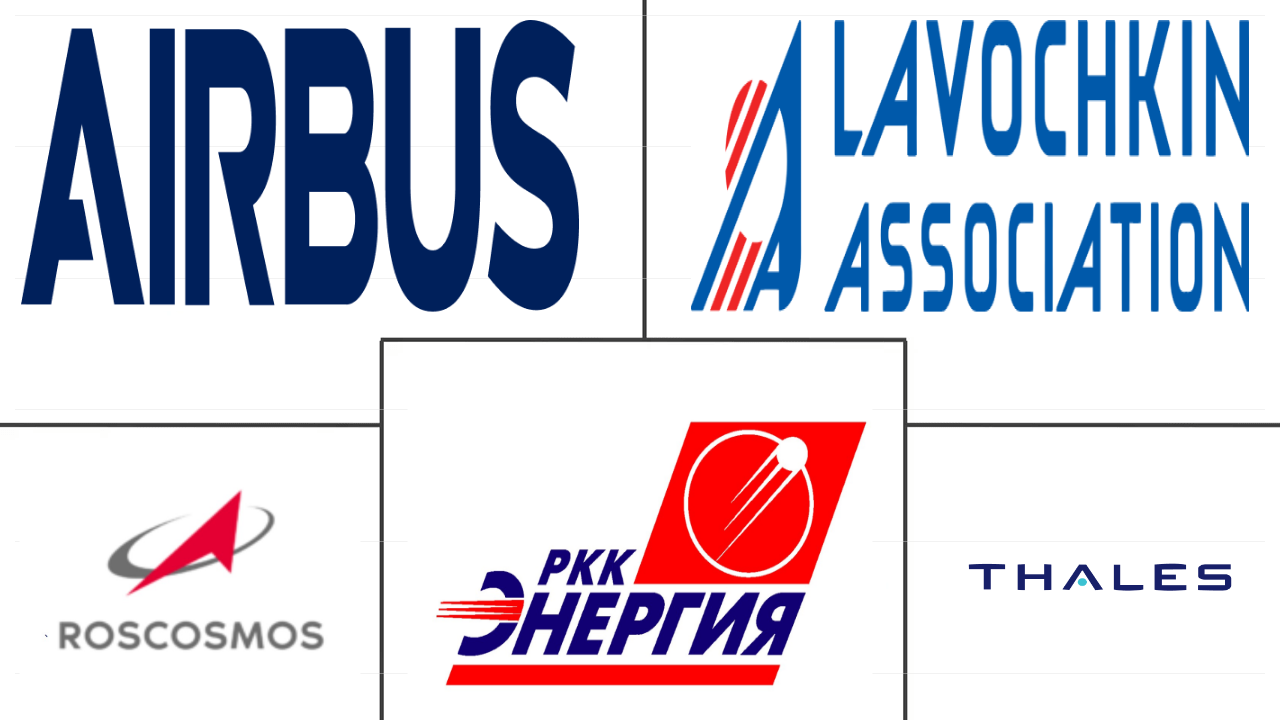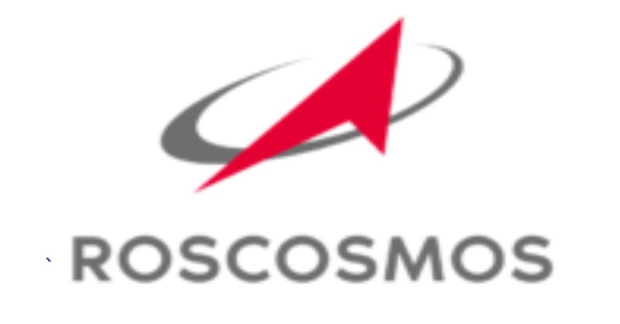Market Size of europe remote sensing satellites Industry

|
|
Study Period | 2017 - 2029 |
|
|
Market Size (2024) | USD 4.93 Billion |
|
|
Market Size (2029) | USD 8.76 Billion |
|
|
Largest Share by Orbit Class | LEO |
|
|
CAGR (2024 - 2029) | 12.18 % |
|
|
Largest Share by Country | United Kingdom |
|
|
Market Concentration | High |
Major Players |
||

|
||
|
*Disclaimer: Major Players sorted in no particular order |
Europe Remote Sensing Satellites Market Analysis
The Europe Remote Sensing Satellites Market size is estimated at USD 4.93 billion in 2024, and is expected to reach USD 8.76 billion by 2029, growing at a CAGR of 12.18% during the forecast period (2024-2029).
4.93 Billion
Market Size in 2024 (USD)
8.76 Billion
Market Size in 2029 (USD)
9.17 %
CAGR (2017-2023)
12.18 %
CAGR (2024-2029)
Largest Market by Satellite Mass
76.63 %
value share, above 1000kg, 2022
Large satellites register higher demand due to applications such as satellite radio, communications, remote sensing, planetary security, and weather forecasting.
Largest Market by Satellite Subsystem
80.28 %
value share, Propulsion Hardware and Propellant, 2022
The demand for these propulsion systems is driven by the launch of mass satellite constellations into space. They are used for transferring the spacecraft into orbit.
Largest Market by Orbit Class
87.05 %
value share, LEO, 2022
LEO satellites are increasingly being adopted in modern communication technologies as they play an important role in Earth observation applications.
Largest Market by End User
92.71 %
value share, Military & Government, 2022
The military and government segment is expected to grow significantly due to the increasing use of satellites in surveillance missions and the rising involvement of government space agencies in satellite development programs.
Leading Market Player
61.39 %
market share, ROSCOSMOS, 2022

Roscosmos, also known as Roscosmos State Corporation for Space Activities, designs and manufactures various remote sensing satellites. It is a major supplier for the Russian Ministry of Defense and Military Space Forces (VKS).
The surge in the number of LEO satellites is driving the growth in the forecast period
- Commercial companies have begun to combine advances in microelectronics, small satellites, and low costs to orbit to create growing low Earth orbit (LEO) sensing constellations: a large number of satellites in multiple orbital planes that facilitate quick review and provide a wide range of low to high-resolution images.
- These commercial advances, combined with the ability to detect outside the visible and infrared (IR) spectrum using synthetic aperture radar (SAR) and radio frequency (RF) mapping, generate new commercial and security applications, from moving target indication to fast jamming geolocation. These commitments are also utilized for other applications and not only for national security.
- Manufacturers have realized the potential of disaster response and have even increased their awareness of changing market conditions by observing the live movement of road freight, global rail, sea, and land.
- Many weather and communication satellites tend to have high Earth orbits farthest from the surface. Satellites in mid Earth orbit include navigational and specialized satellites, which are designed to monitor a specific area. The different satellites produced and launched in this region have different applications. For instance, from 2017 to 2022, of the 16 satellites launched into MEO orbit, most were built for global positioning/navigation purposes. Similarly, of the 15 satellites in GEO orbit, most were deployed for Earth observation and communication purposes. Approximately more than 500 LEO satellites produced and launched belong to European organizations. The market is expected to grow by 69% during the forecast period.
Europe Remote Sensing Satellites Industry Segmentation
10-100kg, 100-500kg, 500-1000kg, Below 10 Kg, above 1000kg are covered as segments by Satellite Mass. GEO, LEO, MEO are covered as segments by Orbit Class. Propulsion Hardware and Propellant, Satellite Bus & Subsystems, Solar Array & Power Hardware, Structures, Harness & Mechanisms are covered as segments by Satellite Subsystem. Commercial, Military & Government are covered as segments by End User.
- Commercial companies have begun to combine advances in microelectronics, small satellites, and low costs to orbit to create growing low Earth orbit (LEO) sensing constellations: a large number of satellites in multiple orbital planes that facilitate quick review and provide a wide range of low to high-resolution images.
- These commercial advances, combined with the ability to detect outside the visible and infrared (IR) spectrum using synthetic aperture radar (SAR) and radio frequency (RF) mapping, generate new commercial and security applications, from moving target indication to fast jamming geolocation. These commitments are also utilized for other applications and not only for national security.
- Manufacturers have realized the potential of disaster response and have even increased their awareness of changing market conditions by observing the live movement of road freight, global rail, sea, and land.
- Many weather and communication satellites tend to have high Earth orbits farthest from the surface. Satellites in mid Earth orbit include navigational and specialized satellites, which are designed to monitor a specific area. The different satellites produced and launched in this region have different applications. For instance, from 2017 to 2022, of the 16 satellites launched into MEO orbit, most were built for global positioning/navigation purposes. Similarly, of the 15 satellites in GEO orbit, most were deployed for Earth observation and communication purposes. Approximately more than 500 LEO satellites produced and launched belong to European organizations. The market is expected to grow by 69% during the forecast period.
| Satellite Mass | |
| Orbit Class | |
| Satellite Subsystem | |
| End User | |
Europe Remote Sensing Satellites Market Size Summary
The Europe Remote Sensing Satellites Market is experiencing significant growth, driven by advancements in microelectronics and the development of low Earth orbit (LEO) sensing constellations. These constellations consist of numerous satellites in multiple orbital planes, enabling rapid reviews and a broad range of imaging capabilities from low to high resolution. The integration of technologies such as synthetic aperture radar (SAR) and radio frequency (RF) mapping has expanded the market's applications beyond national security to include commercial uses like disaster response and logistics monitoring. European countries are at the forefront of this market, with Germany, France, Russia, and the United Kingdom leading in the manufacture of small satellites. The region's focus on cost-effective satellite production and the miniaturization of electronic components have fostered the emergence of new market players, further stimulating growth.
Investment in the space sector is a key driver of the market's expansion, with European nations increasing their funding in areas such as Earth observation, satellite navigation, and space research. The European Space Agency (ESA) and individual countries like France and Germany have proposed significant budget increases to maintain their competitive edge in the global space industry. Initiatives such as the UK's funding for space projects and France's development of a nanosatellite fleet highlight the region's commitment to innovation and technological advancement. The market is fairly consolidated, with major players like Airbus SE, NPO Lavochkin, ROSCOSMOS, RSC Energia, and Thales dominating the landscape. Recent collaborations and contracts, such as those between Airbus Defence and Space and Poland, underscore the ongoing strategic partnerships and developments within the industry.
Europe Remote Sensing Satellites Market Size - Table of Contents
-
1. MARKET SEGMENTATION (includes market size in Value in USD, Forecasts up to 2030 and analysis of growth prospects)
Europe Remote Sensing Satellites Market Size FAQs
How big is the Europe Remote Sensing Satellites Market?
The Europe Remote Sensing Satellites Market size is expected to reach USD 5.45 billion in 2025 and grow at a CAGR of 12.28% to reach USD 9.72 billion by 2030.
What is the current Europe Remote Sensing Satellites Market size?
In 2025, the Europe Remote Sensing Satellites Market size is expected to reach USD 5.45 billion.

